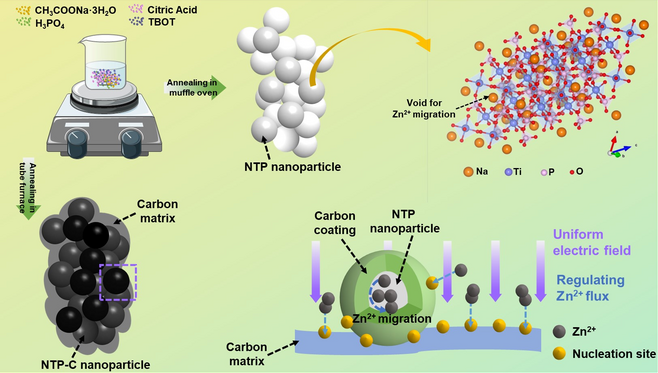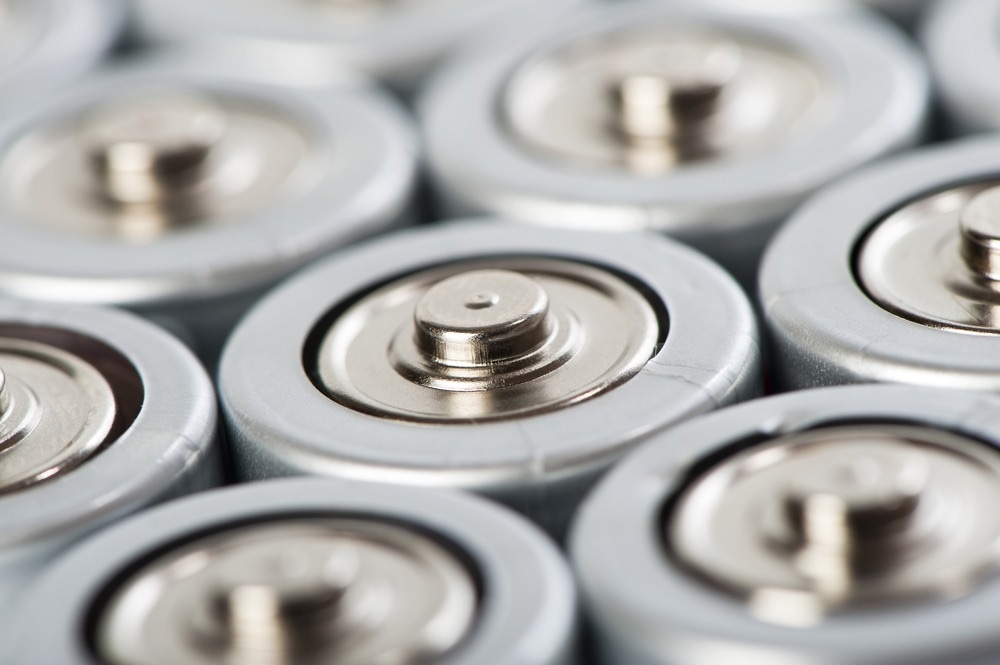Reviewed by Alex SmithDec 5 2022
Despite the many benefits, metallic Zn anode still faces several problems, such as the development of Zn dendrites and adverse reactions (hydrogen evolution, Zn corrosion, and passivation).

Scheme of the Protective mechanisms of NTP-C. Image Credit: Beijing Institute of Technology
These problems result in inconsistent cycling performance with low Coulombic efficiency (CE), capacity fading, and sometimes even short-circuit when the dendrite punctures the separator, which hinders the practical applications of ZIBs and limits their further development. The development of a high-performance metallic Zn anode is, therefore, essential.
Aqueous ZIBs hold great potential as competitive candidates for next-generation energy storage devices. Thanks to their high theoretical capacity, low cost, and high security.
Ying Bai, Study Corresponding Author and Professor, School of Materials Science and Engineering, Beijing Institute of Technology
The direct adoption of a Zn anode, according to Bai, could result in highly competitive gravimetric and volumetric capacities (820 mAh g–1 and 5855 mAh cm–3) as well as a suitable redox potential (–0.762 V versus standard hydrogen), among other anode materials.
Bai and her team published their study in Energy Material Advances on October 3rd, 2022.
According to Bai, numerous methods have been suggested to modify metallic Zn electrodes, including designing the anode structure, alloying it with other metals, enhancing the electrolyte, and constructing artificial protective layers.
Building protective coatings has drawn a lot of interest due to their effective performance improvement, the potential for large-scale manufacturing, and the tunability and designability of their physical and chemical properties. The developments in building artificial layers to stabilize Zn anodes in accordance with protection mechanisms were reviewed by Bai and her team.
To start, porous materials with selective channels and pores, such as nano-CaCO3, Kaolin, Zn-based montmorillonite, and materials based on MOFs, can control Zn2+ flux for stable cycling.
 Image Credit: art nick/Shutterstock.com
Image Credit: art nick/Shutterstock.com
While carbon-based materials like reduced graphene oxide (rGO), porous carbon, and mesoporous hollow carbon enhance the cyclability of ZIBs by expanding the Zn deposition sites, controlling the distribution of the electric field, and decreasing local current density
In addition to inorganic protective layers, polyamide with a distinctive hydrogen-bonding network and coordination with metal ions, polymer Glue, ZnF2, and S/N-rich organic compounds, among others, were developed to stabilize Zn anodes and lengthen lifespans.
However, the polymer components introduced could lead to increased polarization and nucleation overpotential.
Consequently, functional protective layers can still be developed, according to Bai, for stable Zn anodes.
Bai added, “Taking account of Zn dendrites are caused by non-uniform metal deposition, involving uneven electric fields and Zn2+ ion flux. Combining two mechanisms and constructing a NaTi2(PO4)3 with carbon coating (NTP-C) protective layer onto the surface of Zn metal anode can regulate Zn deposition behavior for stable aqueous ZIBs.”
“Since the carbon coated NTP particles are imbedded in the carbon matrix, the protective layer can not only increase the Zn deposition sites for homogeneous nucleation, and uniform electric field for reduced local current density, but also regulate the distribution of Zn2+ flux simultaneously. In such way, the generation of Zn dendrites and side reactions can be suppressed,” Bai further stated.
Bai pointed out, “NTP-C protective layer provides an isolation function between water and Zn and NTP-C@Zn exhibits the highest corrosion potential (−0.987 V vs. Ag/AgCl) compared with bare Zn and NTP@Zn electrodes. The artificial layer can suppress corrosion and protect Zn anode from side reactions to achieve stable cycling among all the three kinds of electrodes.”
“By combining the advantages of NTP and carbon, NTP-C achieves dual Zn deposition layers and further prolongs the lifespan of symmetrical cell to more than 600 hours. The NTP-C protective layer provides a low nucleation overpotential and plating/stripping polarizations in symmetrical cell as well. The NTP-C@Zn symmetrical cell exhibits a stable cycling performance even at a harsh condition (100 mA cm–2), which enables its application in high-load electrodes and supercapacitors,” Bai continued.
She further stated, “Furthermore, the NTP-C coated Zn electrode displays a short nucleation and 2D diffusion period, followed by a 3D diffusion process represented by a stable current density. The constrained 2D diffusion brings about a unaggregated interface, suggesting the adsorbed Zn2+ ions appear to be locally reduced to Zn0 with constrained 2D behavior, which is due to the increased energy barrier for Zn2+ lateral migration and the abundant nucleation sites of the introduced NTP-C coating.”
This work combines two protective mechanisms and provides fresh motivation for real-world Zn metal anode applications in ZIBs. Such a strategy, according to Bai, could aid in the development of suitable metallic anodes for commercialization.
Bai concluded, “Although great progress has been achieved, the development of Zn anodes for ZIBs is still facing massive challenges, such as investigating the electrochemical performance at large deposition areal capacity and high degree of discharge.”
She stated, “In practical application, Zn anode is often matched to a cathode with a high mass loading of active materials, and the capacity ratio between theses electrodes in the battery cell need to be carefully adjusted to achieve a high energy density, long cycle life battery cell. In general, there are still practical issues that need to be paid more attention to investigate.”
Jingjing Yang, Ran Zhao, Yahui Wang, and Chuan Wu, all from the Beijing Institute of Technology’s School of Materials Science and Engineering, are the other contributors.
This research was funded by the Beijing Institute of Technology’s Graduate Interdisciplinary Innovation Project of Yangtze Delta Region Academy (Jiaxing, Grant No. GIIP2021-010) and the National Natural Science Foundation of China (Grant No. 22075028).
Journal Reference:
Yang, J., et al. (2022) Regulating Uniform Zn Deposition via Hybrid Artificial Layer for Stable Aqueous Zn-Ion Batteries. Energy Material Advances. doi:10.34133/2022/9809626.